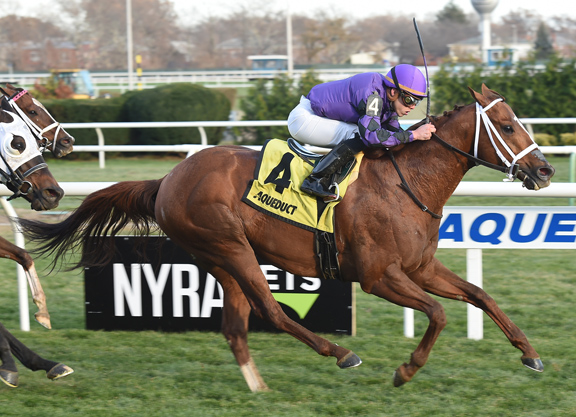By T. D. Thornton
Monday's New York State Gaming Commission (NYSGC) meeting generated a trio of Thoroughbred rule passages dealing with equine treatment practices, safety standards, and the refinement of the state's multiple medication violation (MMV) policy.
But discussion among board members also signaled that the NYSGC is beginning to formulate what a near-future Lasix phase-out rule might look like if and when the board receives a formal request from the New York Racing Association to take up a proposal that mirrors goals set forth by a multi-track national coalition to end Lasix usage in juveniles starting in 2020 and in all stakes races at participating tracks by 2021.
Any possible rule-making process for a possible Lasix phase-out in New York is likely to be different from that in other states because, as one board member noted, the NYSCG's rules cover not only the three NYRA tracks (which have aligned themselves with the phase-out coalition), but also Finger Lakes (which is not currently part of the national group of tracks advocating to curtail Lasix usage).
“I think that it's important to get veterinary input on this. I think that there's a lot of misconception about what this drug does, and how it is used to control exercise-induced pulmonary hemorrhage,” said NYSGC equine medical director Scott Palmer, VMD. “And I think the medical positions and the medical concerns have not been taken into consideration by the coalition racetracks.”
It was also revealed that Palmer, in the wake of enhanced NYSGC pre-race veterinary protocols that were put in place at Aqueduct during the recently concluded winter meet, is planning a “more refined analytical presentation” about how that process works for the NYSGC's monthly meeting in May.
“The fatality rate at this Aqueduct meet was 0.88 per thousand,” Palmer said by way of summation for the Jan. 1-Mar. 31 portion of the NYRA season. “Last year it was 1.5. So we've got some terrific progress in that area as well.”
The three rules that got voted in were:
Treatment of Thoroughbred Horses Before a Race–By unanimous voice vote, the NYSGC voted to allow the treatment of Thoroughbred racehorses with ultrasonic, diathermy or other electro/medical equipment treatments up until 24 hours before the scheduled post time of a horse's race. According to a brief written by NYSGC general counsel Edmund Burns that was included in the informational packet for Monday's meeting, the previous rule had stipulated treatment was restricted to “24 hours before the start of the racing program, regardless of which race the horse is entered to compete,” and that the new protocol “has no effect on race integrity and has the endorsement of the New York Thoroughbred Horsemen's Association.”
Helmets and Safety Vests at Thoroughbred Racetracks–By unanimous voice vote, the NYSGC voted in a requirement that “helmets and safety vests must be worn by any person” loading the horses into the starting gate or while mounted on any horse on the grounds of a Thoroughbred racetrack.” According to a summary written by Burns, the proposal also increases “the maximum weight of the safety vest from two to four pounds to permit newer vest models that provide enhanced safety.”
MMV rules alignment–By a 3-2 vote, the NYSGC voted to conform New York's mandatory minimum medication violation penalty rules “to changes in the national model rules adopted by the Association of Racing Commissioners International.” According to Burns, the previous “minimum penalty enhancement rules, adopted by the [NYSGC] in February 2016, were designed to ensure that every state imposes a mandatory minimum penalty whenever a horseperson, typically the trainer, reaches a certain level of multiple equine drug violations…. The [new] revisions will appropriately focus the MMV system on those who consistently violate serious medication and anti-doping rules and assist in developing national consistency in regard to punishment.”
Not a subscriber? Click here to sign up for the daily PDF or alerts.






